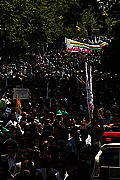Regime Fearful of Crisis and Riots
» Government Organizes Seminars on “Future Seditions”
After issuing repeated warnings about the “future seditions” and even launching a website with this very name, the Iranian regime has embarked on organizing seminars on future protests and the city of Qom is the first stop.
Cleric Mojtaba Zolnoor the deputy representative of Iran’s supreme leader in the Revolutionary Guards Corps (IRGC) was one speaker of such a seminar titled, “The Future Sedition” that was held last Monday evening in a mosque in Qom. Sedition is the term officials of the Islamic republic use to describe the massive popular anti-government demonstrations in 2009 in protest to the official announcement of the results of the presidential elections which they say were widely rigged.
In his talk, while declaring with certainty that future seditions would take place in Iran, Zolnoor said “The difference between the next sedition and the previous ones will be its depth and the naked presence of some of the revolutionary personalities who are carrying riding on their past revolutionary accomplishments.”
Mohammad Ali Tofighi, an Iranian journalist living in France who is also a former member of the Sazemane Mujahedin Engelabe Eslami (the Organization for the Mujahedin of the Islamic Revolution) – a group that belongs to the reformist camp and at one time had a presence in the Iranian regime – believes that when regime officials and authorities make such a prediction it indicates that they know the situation in the country very well and know that “these conditions are not durable.” He believes that the Iranian regime uses the term sedition for any criticism or opposition to the existing conditions in the country.
Deeper and More Complex
In his talk, Zolnoor also predicted that future protests in the country would be “deeper and more complex.” He accused individuals who held religious titles and used to be close to the founder of the Islamic regime ayatollah Khomeini of being part of the “sedition” and added that they would play a dominant role in these events.
Iranian government authorities claim that protestors to the 2009 presidential election results, including presidential contenders Mir-Hossein Mousavi and Mehdi Karoubi, have played a role in the “sedition” by claiming that the elections were rigged and that the regime was “lying” about it.
In contrast, these two candidates and their supporters stress on the wide rigging that took place in the process of the elections and voting in the course of the 2009 presidential race and voting and accuse the security and political agencies of the regime to have engineered the rigging.
Following the long protests in Tehran and some of the other large cities in Iran against the announced results of the 2009 presidential elections, many protestors chanted slogans against the whole regime, something that was completely unprecedented for its size since the 1979 revolution that toppled the monarchy.
Getting Ready for the Future
Zolnoor is not the only authority to speak with certainty of future riots and protests. Speaking on the subject, Alireza Zakani, a prominent Principlist deputy in the Majlis has said that future protests will be “more complex” than the 2009 events and warned that the issue had to be taken very seriously.
Zakani, who is a former security official in the Islamic republic, said, “If you ignore last year’s sedition, we shall be caught up in a larger one in the future and just as the Islamic revolution has become more complex, the seditions of the foreign and domestic enemies too have become deeper and more complex. ” He warned that the future protests would unveil a new version of “American Islam” which would negate the clerical succession and would strive to burn the roots of the pure Islam that was present in Iran.
Another cleric, Alireza Panahian, a head of a leadership think tank in the universities also warned on June 4, 2010, “Future seditions that will take place will bring forth individuals who will possess religious and revolutionary credentials and who will provide religious sources ” for their views and actions.
Hossein Safar Herandi, the former minister of culture in Ahmadinejad’s administration and current advisor to the IRGC supreme commander also has expressed similar predictions. “The new plan of the enemies is to attack religious beliefs, the Velayat Faghih (rule of clerics), leadership, presenting a different ideology and the Iranian republic versus the Islamic republic are the ploys of the future sedition that will be launched,” he said on February 21, 2011.
Journalist Tofighi believes that the Islamic republic is engulfed in a range of crises in the political, economic, cultural, social etc realms. And because its rulers are aware of this, these predictions are in fact a way for it to prepare for the future challenges. Tofighi has his own prediction and adds that the rulers of Iran cannot continue to use these labels and violent suppression of protesting voice for a long time.


